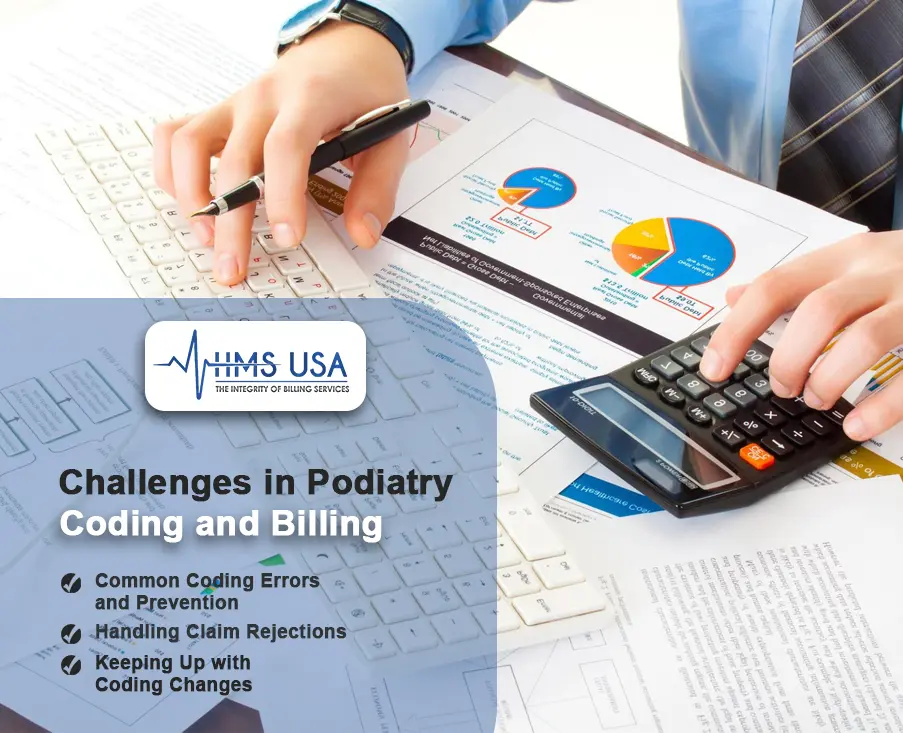
A Comprehensive Guide to Podiatry Coding and Billing and Practice Management
The complex diagnosis and treatment of foot and lower extremity problems is the focus of podiatry. As podiatric offices grow, attention goes to correct coding and invoicing for a smooth performance. Each podiatrist operation and diagnosis is a delicate dance. Not only is healing important, but so is translating patient care into billing and regulatory system language. This enlightening journey will teach you about “Podiatry Coding and Billing“—the foundation of a well-managed podiatric practice.
Enter a world where codes are brushes, painting fair compensation and regulatory compliance. This blog takes you behind the scenes of podiatric administration and examines what makes a clinic great. Let’s enter podiatry, where correct coding is the rhythm that unites the discipline.
Understanding Podiatry Coding
To appropriately document and charge podiatric operations, CPT codes are needed. Healthcare providers, insurers, and administrators can communicate more easily with these codes. Podiatry uses CPT codes to represent routine exams and surgical operations.
Common Podiatry CPT Codes
Podiatric procedures range from nail care to sophisticated surgery. Nail avulsion (11730), bunionectomy (28292), and arthroscopic operations are common CPT codes. Coding specialists must know these codes to appropriately represent services.
ICD-10 Codes in Podiatry
ICD-10 codes are essential for diagnosing and classifying podiatric conditions. Healthcare practitioners, insurers, and academics can communicate medical conditions using these alphanumeric codes.
Commonly Used Codes for Podiatric Diagnosis
Podiatrists manage many ailments that require precise diagnosis coding. ICD-10 codes for plantar fasciitis (M72.2), ingrown toenails (L60.0), and diabetic foot ulcer (E11.621) are common in podiatry. A thorough understanding of these codes is necessary for accurate invoicing and reimbursement.
Evaluation and Management (E/M) codes, together with procedural and diagnostic codes, indicate podiatrists’ time and skill in patient care. E/M codes cover patient history, physical exams, and medical decisions.
For detailed information about CPT: What are the CPT Codes for Mental Health Billings? – 2024
Key Considerations in Podiatry Coding and Billing
Accurate Documentation Matters
Effective podiatry billing requires accurate documentation. Accurate records ensure reimbursement and document patient care. Podiatrists must properly record diagnosis, treatments, and procedures. This improves healthcare provider communication, billing accuracy, and continuity of care.
Claim Submission in Time
Podiatry billing success depends on timeliness. Delaying claims can postpone payments, hurting the practice’s finances. Podiatrists should streamline insurance claim submissions. Healthcare providers and billing personnel must work together to reduce the time between service delivery and claim submission.
Understanding Insurance Rules
Successful podiatrist billing requires knowledge of insurance coverage. Insurers have different standards, authorization processes, and reimbursement rates. Podiatrists and billing staff must know their insurance plans’ policies. This information enables correct billing, lowers claim denials, and boosts podiatric practice profitability.
Challenges in Podiatry Coding and Billing

Common Coding Errors and Prevention
Coding errors can delay payments, deny claims, and trigger audits. Misuse of CPT or ICD-10 codes, undercoding or overcoding, and neglecting to establish medical necessity are common problems. Coding staff training and audits can discover and correct coding problems, assuring compliance and accurate reimbursement.
Handling Claim Rejections
In complex podiatry coding and billing, claim denials and rejections are unavoidable. Denials due to code flaws, pre-authorization difficulties, or other issues must be understood. Denial management solutions including timely resubmission of rectified claims and root cause resolution reduce revenue loss and boost cash flow.
Keeping Up with Coding Changes
Podiatry Practice Management
Podiatry practice management includes administrative and operational measures that boost efficiency and success. Coordination includes patient care, scheduling, billing, and compliance. For podiatric practices to provide great care and stay profitable, practice management must be efficient.
Effective Scheduling and Patient Management
Podiatry practices must streamline appointment scheduling and patient management. Effective scheduling systems optimize healthcare providers’ time and improve patient experience. Practices should reduce wait times, improve patient communication, and streamline appointments. Patient management requires clear instructions, reliable records, and favorable patient-doctor interactions.
Use Technology to Improve Practice Efficiency
Technology is essential to modern podiatry practice administration. EHRs, appointment scheduling, and billing systems improve efficiency and minimize administrative burdens. Using technology enhances record-keeping and communication between practice departments. Telehealth technologies can also improve access to care, especially for follow-ups and consultations.
Best Practices for Podiatry Coding and Billing
Regular Staff Coding Update Training
Maintaining industry-standard coding and billing processes requires ongoing staff training. Keeping up with CPT and ICD-10 code changes requires ongoing training for podiatrists and their coding staff. Proactively maintaining precise coding processes reduces errors and claim denials.
Specialized Coding and Billing Software
Dedicated coding and billing software can boost podiatrist efficiency. These technologies simplify coding, decrease errors, and help submit proper claims. Podiatrists should invest in user-friendly software that meets their practice’s demands to increase financial results.
Regular Compliance Audits
Monitoring coding and billing compliance with regular audits is proactive. Internal and external audits might find coding and billing errors and improvements. Regular audits allow podiatrists to resolve concerns quickly, improve compliance, and reduce legal and financial risks.
Conclusion
A podiatry practice must integrate coding, invoicing, and practice management to succeed and survive. This blog has covered the basics of podiatry coding and billing. Lastly, podiatrists must maintain the importance of correct billing and coding if they want their business to be great and last. Accurate coding enables fair reimbursement and regulatory compliance, boosting the practice’s credibility. Cash flow depends on timely claims submission and insurance policy knowledge.
Best practices including staff coding update training, specialized coding and billing software, and compliance audits help podiatrists manage healthcare reimbursement. These approaches boost podiatrist practice growth and billing accuracy.
Coding, invoicing, and practice administration skills boost podiatric practice repute. Podiatrists can excel in the changing healthcare administration landscape by staying informed, utilizing technology, and supporting continual improvement.
FAQs
For fair payment and to follow the rules, you need to code correctly. It makes sure that podiatrists get paid fairly and protects the job.
Modern scheduling, technology, and shorter wait times can improve podiatry efficiency. This simplifies appointments and improves patient satisfaction.
Coding errors, claim denials, and revisions are billing difficulties. Specialist software, staff training, and compliance inspections assist podiatrists address these issues.
Managing a podiatry business is important for taking care of patients and billing. A clinic can do well by improving customer satisfaction, streamlining processes, and making sure the finances are in good shape.
EHRs, meeting scheduling software, and specialized billing systems are all examples of technology that can be used together. These tools make the podiatry business more accurate, easier to communicate with, and more productive.











